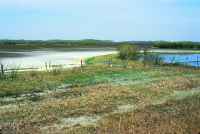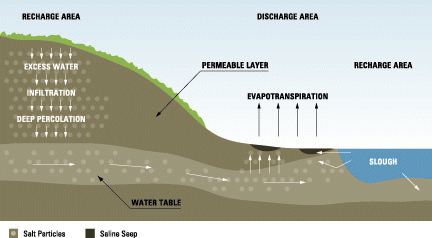| | Saline soils contain excess soluble salts in the root zone. High salt concentrations limit the plant root's ability to take up water and nutrients, which restricts crop growth and reduces yields.
.

Saline seeps can form where salty groundwater discharges.
Courtesy of ARD
In Alberta, salts occur naturally in many bedrock deposits and in some deposits on top of the bedrock. Groundwater flowing through these deposits dissolves and transports the salts. Under certain conditions, groundwater discharges at the soil surface. When the water evaporates, the salts are left behind. Over time, the salts accumulate in the groundwater discharge area, forming a saline seep (Figure 2.4). A white salt crust forms where the salt concentration is very high. Only salt-tolerant plants grow in these visibly saline areas (see Table 2.2). The land around the visibly saline area often has saline subsoils, which can lower crop yields.
A saline seep is fed by one or more recharge areas. In a recharge area, water in excess of the soil's water-holding capacity moves below the root zone. This movement raises the local water table, causing the groundwater to flow downslope. Groundwater flows through the subsoil or bedrock, and dissolves and transports salts in the soil. Eventually, the groundwater discharges near or at the soil surface and a seep gradually forms.

Figure 2.4. Generalized saline seep formation
Adapted from: Wentz, D. 2000. Dryland Saline Seeps: Types and Causes. Agriculture, Food and Rural Development, Agdex FS518-12.
Soil salinity can be measured by electrical conductivity (EC), a measurement of the flow of electricity through a material, such as water or a soil solution. The more salts in the soil sample, the greater its electrical conductivity. EC measurements are usually expressed in deciSiemens per metre (dS/m).
Other types of salt-affected soils - Saline soils are one type of salt-affected soil. The two other types are:
- sodic soils, which are affected by too much sodium, and
- saline-sodic soils, which are affected by an excess of both soluble salts and sodium.
Some practices suited to saline soils can be used for saline-sodic soils. Sodic soils, however, require different management than saline soils. Sodic soils have restricted water movement, are easy to get stuck in when wet, form lumpy seed beds and often have unfavourable pH for crop growth.
People sometimes refer to both saline soils and sodic soils as 'alkali soils', an outdated term used to describe soils with sufficient sodium levels affecting crop growth. To add to the confusion, people sometimes mix up alkaline (high pH) soils with alkali soils. The result can be a misunderstanding of the actual soil condition and use of unsuitable management practices.
If you suspect that you have salt-affected soils, collect samples from the affected area, have them analyzed by a laboratory, and contact a soil specialist to interpret the results.
Table 2.2. Salt tolerance of plants
Adapted from: Wentz, D. 2001. Salt Tolerance of Plants. Alberta Agriculture and Rural Development,
Agdex FS518-17.
Factors affecting the formation of saline seeps:
- Generally, recharge areas occur in upper slope positions, while discharge areas occur in lower slope positions.
- Periods of high precipitation and irrigation canal seepage can increase the risk of seep
- Growing high-moisture-use crops, like alfalfa, in recharge areas can reduce the flow of water to discharge areas.
- Summerfallow in recharge areas can increase the risk of saline seep formation because there are no crops to take up moisture from deep in the soil.
Manure and salt accumulation in soils - Manure contains salt originating from the salt in animal rations. Overapplication of manure can lead to increased levels of salt in soil. See Section 9.1.1 for information about manure application regulations to prevent salt accumulation.
Back to Chapter 2 - Environmental Considerations |
|